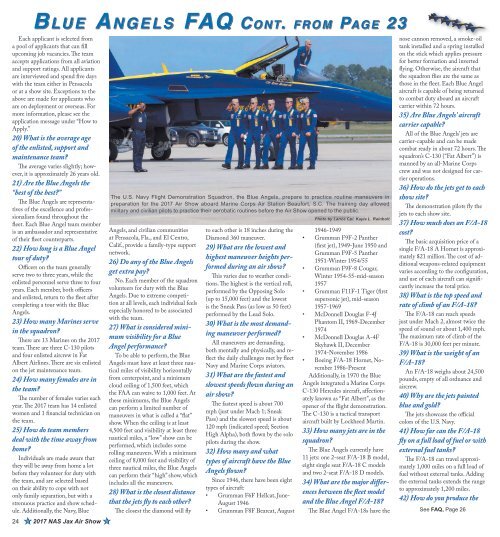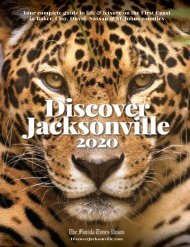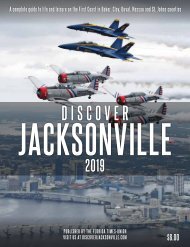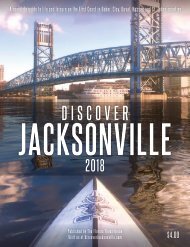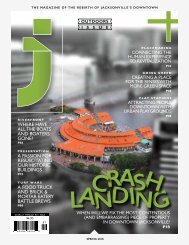You also want an ePaper? Increase the reach of your titles
YUMPU automatically turns print PDFs into web optimized ePapers that Google loves.
B lu e An g e ls FAQ Cont. from Pag e 23<br />
Each applicant is selected from<br />
a pool of applicants that can fill<br />
upcoming job vacancies. The team<br />
accepts applications from all aviation<br />
and support ratings. All applicants<br />
are interviewed and spend five days<br />
with the team either in Pensacola<br />
or at a show site. Exceptions to the<br />
above are made for applicants who<br />
are on deployment or overseas. For<br />
more information, please see the<br />
application message under “How to<br />
Apply.”<br />
20) What is the average age<br />
of the enlisted, support and<br />
maintenance team?<br />
The average varies slightly; however,<br />
it is approximately 26 years old.<br />
21) Are the Blue Angels the<br />
“best of the best?”<br />
The Blue Angels are representatives<br />
of the excellence and professionalism<br />
found throughout the<br />
fleet. Each Blue Angel team member<br />
is an ambassador and representative<br />
of their fleet counterparts.<br />
22) How long is a Blue Angel<br />
tour of duty?<br />
Officers on the team generally<br />
serve two to three years, while the<br />
enlisted personnel serve three to four<br />
years. Each member, both officers<br />
and enlisted, return to the fleet after<br />
completing a tour with the Blue<br />
Angels.<br />
23) How many Marines serve<br />
in the squadron?<br />
There are 13 Marines on the 2017<br />
team. There are three C-130 pilots<br />
and four enlisted aircrew in Fat<br />
Albert Airlines. There are six enlisted<br />
on the jet maintenance team.<br />
24) How many females are in<br />
the team?<br />
The number of females varies each<br />
year. The 2017 team has 14 enlisted<br />
women and 1 financial technician on<br />
the team.<br />
25) How do team members<br />
deal with the time away from<br />
home?<br />
Individuals are made aware that<br />
they will be away from home a lot<br />
before they volunteer for duty with<br />
the team, and are selected based<br />
on their ability to cope with not<br />
only family separation, but with a<br />
strenuous practice and show schedule.<br />
Additionally, the Navy, Blue<br />
24 ó 2017 NAS Jax Air Show ó<br />
The U.S. Navy Flight Demonstration Squadron, the Blue Angels, prepare to practice routine maneuvers in<br />
preparation for the 2017 Air Show aboard Marine Corps Air Station Beaufort, S.C. The training day allowed<br />
military and civilian pilots to practice their aerobatic routines before the Air Show opened to the public.<br />
Photo by Lance Cpl. Kayla L. Rainbolt<br />
Angels, and civilian communities<br />
at Pensacola, Fla., and El Centro,<br />
Calif., provide a family-type support<br />
network.<br />
26) Do any of the Blue Angels<br />
get extra pay?<br />
No. Each member of the squadron<br />
volunteers for duty with the Blue<br />
Angels. Due to extreme competition<br />
at all levels, each individual feels<br />
especially honored to be associated<br />
with the team.<br />
27) What is considered minimum<br />
visibility for a Blue<br />
Angel performance?<br />
To be able to perform, the Blue<br />
Angels must have at least three nautical<br />
miles of visibility horizontally<br />
from centerpoint, and a minimum<br />
cloud ceiling of 1,500 feet, which<br />
the FAA can waive to 1,000 feet. At<br />
these minimums, the Blue Angels<br />
can perform a limited number of<br />
maneuvers in what is called a “flat”<br />
show. When the ceiling is at least<br />
4,500 feet and visibility at least three<br />
nautical miles, a “low” show can be<br />
performed, which includes some<br />
rolling maneuvers. With a minimum<br />
ceiling of 8,000 feet and visibility of<br />
three nautical miles, the Blue Angels<br />
can perform their “high” show, which<br />
includes all the maneuvers.<br />
28) What is the closest distance<br />
that the jets fly to each other?<br />
The closest the diamond will fly<br />
to each other is 18 inches during the<br />
Diamond 360 maneuver.<br />
29) What are the lowest and<br />
highest maneuver heights performed<br />
during an air show?<br />
This varies due to weather conditions.<br />
The highest is the vertical roll,<br />
performed by the Opposing Solo<br />
(up to 15,000 feet) and the lowest<br />
is the Sneak Pass (as low as 50 feet)<br />
performed by the Lead Solo.<br />
30) What is the most demanding<br />
maneuver performed?<br />
All maneuvers are demanding,<br />
both mentally and physically, and reflect<br />
the daily challenges met by fleet<br />
Navy and Marine Corps aviators.<br />
31) What are the fastest and<br />
slowest speeds flown during an<br />
air show?<br />
The fastest speed is about 700<br />
mph (just under Mach 1; Sneak<br />
Pass) and the slowest speed is about<br />
120 mph (indicated speed; Section<br />
High Alpha), both flown by the solo<br />
pilots during the show.<br />
32) How many and what<br />
types of aircraft have the Blue<br />
Angels flown?<br />
Since 1946, there have been eight<br />
types of aircraft:<br />
• Grumman F6F Hellcat, June-<br />
August 1946<br />
• Grumman F8F Bearcat, August<br />
1946-1949<br />
• Grumman F9F-2 Panther<br />
(first jet), 1949-June 1950 and<br />
Grumman F9F-5 Panther<br />
1951-Winter 1954/55<br />
• Grumman F9F-8 Cougar,<br />
Winter 1954-55-mid-season<br />
1957<br />
• Grumman F11F-1 Tiger (first<br />
supersonic jet), mid-season<br />
1957-1969<br />
• McDonnell Douglas F-4J<br />
Phantom II, 1969-December<br />
1974<br />
• McDonnell Douglas A-4F<br />
Skyhawk II, December<br />
1974-November 1986<br />
• Boeing F/A-18 Hornet, November<br />
1986-Present<br />
Additionally, in 1970 the Blue<br />
Angels integrated a Marine Corps<br />
C-130 Hercules aircraft, affectionately<br />
known as “Fat Albert”, as the<br />
opener of the flight demonstration.<br />
The C-130 is a tactical transport<br />
aircraft built by Lockheed Martin.<br />
33) How many jets are in the<br />
squadron?<br />
The Blue Angels currently have<br />
11 jets: one 2-seat F/A-18 B model,<br />
eight single seat F/A-18 C models<br />
and two 2-seat F/A-18 D models.<br />
34) What are the major differences<br />
between the fleet model<br />
and the Blue Angel F/A-18?<br />
The Blue Angel F/A-18s have the<br />
nose cannon removed, a smoke-oil<br />
tank installed and a spring installed<br />
on the stick which applies pressure<br />
for better formation and inverted<br />
flying. Otherwise, the aircraft that<br />
the squadron flies are the same as<br />
those in the fleet. Each Blue Angel<br />
aircraft is capable of being returned<br />
to combat duty aboard an aircraft<br />
carrier within 72 hours.<br />
35) Are Blue Angels’ aircraft<br />
carrier capable?<br />
All of the Blue Angels’ jets are<br />
carrier-capable and can be made<br />
combat ready in about 72 hours. The<br />
squadron’s C-130 (“Fat Albert”) is<br />
manned by an all-Marine Corps<br />
crew and was not designed for carrier<br />
operations.<br />
36) How do the jets get to each<br />
show site?<br />
The demonstration pilots fly the<br />
jets to each show site.<br />
37) How much does an F/A-18<br />
cost?<br />
The basic acquisition price of a<br />
single F/A-18 A Hornet is approximately<br />
$21 million. The cost of additional<br />
weapons-related equipment<br />
varies according to the configuration,<br />
and use of each aircraft can significantly<br />
increase the total price.<br />
38) What is the top speed and<br />
rate of climb of an F/A-18?<br />
The F/A-18 can reach speeds<br />
just under Mach 2, almost twice the<br />
speed of sound or about 1,400 mph.<br />
The maximum rate of climb of the<br />
F/A-18 is 30,000 feet per minute.<br />
39) What is the weight of an<br />
F/A-18?<br />
An F/A-18 weighs about 24,500<br />
pounds, empty of all ordnance and<br />
aircrew.<br />
40) Why are the jets painted<br />
blue and gold?<br />
The jets showcase the official<br />
colors of the U.S. Navy.<br />
41) How far can the F/A-18<br />
fly on a full load of fuel or with<br />
external fuel tanks?<br />
The F/A-18 can travel approximately<br />
1,000 miles on a full load of<br />
fuel without external tanks. Adding<br />
the external tanks extends the range<br />
to approximately 1,200 miles.<br />
42) How do you produce the<br />
See FAQ, Page 26


